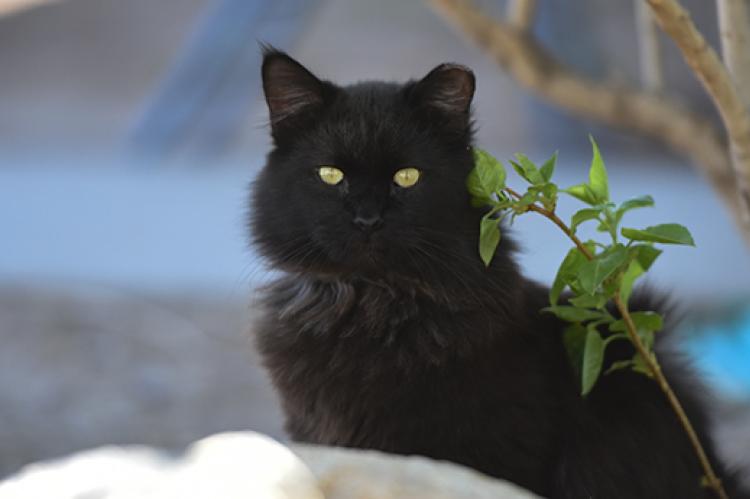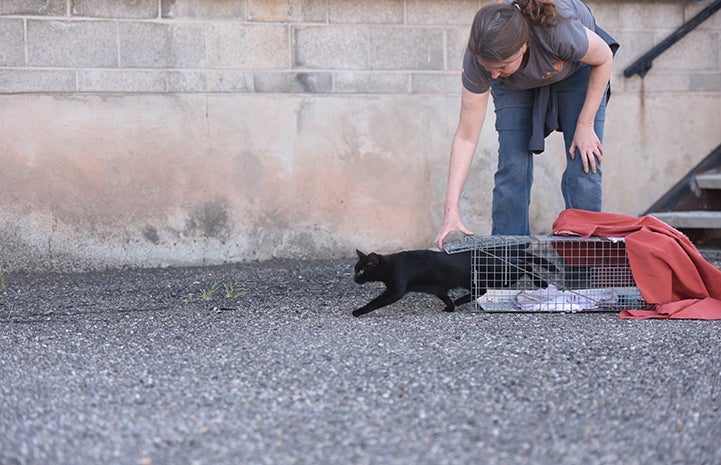What Every Advocate Should Know About Community Cats

If you see a cat outdoors, the cat could be stray, feral, or free-roaming. Those terms are often used interchangeably by the general public when referring to cats who live outdoors. At Best Friends Animal Society, we like to call these outdoor cats "community cats" because they are valued members of our community and are often cared for by community members.
Trap-neuter-vaccinate-return (TNVR) is a common-sense, cost-effective solution for managing community cat populations by preventing additional births — rather than trying to round up, house, feed, and kill more cats. Despite TNVR becoming increasingly popular over the past few decades, a great deal of misinformation exists regarding TNVR programs and community cats in general.
To protect the cats, yourself, and your community, you need to separate the fact from fiction. Here's what every community cat advocate should know.
Community cat fact vs. fiction
Fiction: TNVR doesn’t work.
Facts: The science is quite clear: There are only two ways proven to reduce, and eventually eliminate, a population of community cats: intensive TNVR efforts or intensive eradication efforts, such as those done using poison, disease, lethal trapping, and hunting on small oceanic islands.1,2 Given the horrendous methods employed — and costs that can exceed $100,000 per square mile3 — eradication is a nonstarter in the U.S.
The only fiscally sound option, then, is TNVR. Arguments about the limitations of its effectiveness, the alleged impact of outdoor cats on the environment, and so forth largely miss the point. In the vast majority of instances, TNVR is simply the best option available to humanely reduce the outdoor cat population and any related nuisance complaints.
Fiction: TNVR doesn’t eliminate the population of community cats.
Facts: Elimination of a particular population of cats can be quite difficult, as even the most intensive eradication programs have demonstrated. Complete elimination can also backfire when, for example, the population of an island’s rodents skyrockets — threatening the very wildlife whose protection prompted the eradication campaign.4,5 Nevertheless, a number of TNVR programs have demonstrated dramatic population reductions and, in some cases, have completely eliminated community cat colonies. Among the most well-documented examples:
- In Florida, a campus TNVR program led to the adoption of 47% of the 155 cats living on campus over an 11-year observation period — at the end of which, just 23 cats remained on campus.6
- In Rome, Italy, a survey of caregivers (caring for 103 cat colonies) revealed a 22% decrease overall in the number of cats, despite a 21% rate of “cat immigration.” Although some colonies experienced initial increases, the numbers began to decrease significantly after three years of TNVR. From a report on the survey: “Colonies neutered three, four, five or six years before the survey showed progressive decreases of 16, 29, 28 and 32 percent, respectively.”7
- A recent survey conducted among 28 respondents involved with TNVR efforts in Australia (with usable data from a total of 42 colonies) revealed a median decline in colony size “from 11.5 to 6.5 cats … over a median of 2.2 years, and the median … reduction was 31 percent; this was achieved by rehoming cats and kittens and reducing reproduction.”8
- A 17-year TNVR effort on the waterfront in Newburyport, Massachusetts, resulted in the elimination of an estimated 300 cats.9
- In Chicago, Illinois, a citizen scientist implementing a targeted TNVR program documented a mean population reduction (across 20 colonies) of 54% from entry levels and 82% from peak levels.10
Fiction: TNVR compromises the welfare of community cats.
Facts: Best Friends Animal Society operates more large-scale TNVR programs than any other organization in the country; as such, we are in a unique position to comment on the positive impact of these programs. Our firsthand experience, and evidence from a number of studies, shows that the vast majority of community cats are healthy — even thriving.
During an 11-year observation period, more than half of the 23 cats living continuously on the University of Central Florida campus were estimated to be 6.8 years old or older, for example.6
A 2012 nationwide survey conducted by Alley Cat Rescue revealed similar longevity: A quarter of TNVR organizations responding to the survey had colony cats in the 6–8 year range, and 35% had cats in the 9–12 year range, while 14% reported caring for cats 13 years of age or older.11 And a number of studies have found that cats involved with TNVR programs are “surprisingly healthy and have good body weight.”12–14
The research shows that well-managed TNVR colony cats are, generally speaking, just as healthy as indoor-outdoor pet cats,15 with rates of feline leukemia virus (FeLV) and feline immunodeficiency virus (FIV) infection “similar to infection rates reported for owned cats.”16 Comparable findings have been reported in Ottawa, Ontario.17 By contrast, significantly higher rates of both FeLV and FIV have been observed where no active TNVR program had been implemented.13
Fiction: TNVR encourages the abandonment of cats and kittens, and it might actually be considered abandonment.
Facts: TNVR is not abandonment; healthy cats are merely being returned to their neighborhoods. Existing anti-cruelty statutes that address the act of abandonment are contingent upon the critical elements of intent and the foreseeable harm that might result from a person’s deliberate decision to withdraw necessary care.
Returning healthy cats to their original location after sterilization and vaccination obviously does not meet the legal requirements for abandonment because their healthy condition suggests that these cats have ample access to resources — and therefore the intention underlying the return of these cats is noble and the foreseeable harm minimal.
Although it’s true that TNVR programs are sometimes faced with the unfortunate (and illegal) dumping of cats and kittens at colony feeding sites, there’s simply no evidence to suggest that these cats and kittens would not have been dumped anyway.
Moreover, cats abandoned near a managed colony are far more likely to be adopted (multiple studies have found that approximately 30–50% or more of TNVR cats are adopted into homes6,12,10,9) and/or sterilized and vaccinated, thereby mitigating their potential impact on the overall population of community cats (as well any potential impacts on wildlife and the environment).

Fiction: Most residents are opposed to TNVR for managing the community cats in their neighborhood.
Facts: Results of a 2014 national survey commissioned by Best Friends revealed a 68% preference for TNVR over impoundment followed by lethal injection of unadoptable cats (24%).18 That’s nearly 3-to-1 in favor of TNVR. More recently, a 2017 survey (also commissioned by Best Friends) found nearly identical results: 72% of respondents supported TNVR, compared to just 18% favoring impoundment and lethal injection. At a time when Americans are divided about so many policy issues, roughly 7 in 10 agree that TNVR is the best way to manage community cats.
Results of a 2006 survey commissioned by Alley Cat Allies found that 81% of respondents thought “leaving a cat where it is outside” was more humane for the cat, compared to the alternative of “having the cat caught and then put down” (14%).19
When respondents were asked the same question — but were told to assume the cat would die two years later after being hit by a car — the support for “leaving the cat” remained strong, at 72% (with 21% preferring to have the cat caught and euthanized).
The same questions were asked in two subsequent surveys, the results of which again indicated strong preference (e.g., 73–86% of respondents for the first question) for “leaving the cat where it is outside.”20,21
Such attitudes are in line with the results of a 2011 national survey in which just 25% of respondents agreed that animal shelters “should be allowed to euthanize animals as a necessary way of controlling the population of animals.”22
Literature cited
(1) Bester, M. N.; Bloomer, J. P.; Aarde, R. J. van; Erasmus, B. H.; Rensburg, P. J. J. van; Skinner, J. D.; Howell, P. G.; Naude, T. W. A Review of the Successful Eradication of Feral Cats from Sub-Antarctic Marion Island, Southern Indian Ocean. South African Journal of Wildlife Research 2002, 32 (1), 65–73.
(2) Ratcliffe, N.; Bell, M.; Pelembe, T.; Boyle, D.; Benjamin, R.; White, R.; Godley, B.; Stevenson, J.; Sanders, S. The Eradication of Feral Cats from Ascension Island and Its Subsequent Recolonization by Seabirds. Oryx 2009, 44 (01), 20–29.
(3) Campbell, K. J.; Harper, G.; Algar, D.; Hanson, C. C.; Keitt, B. S.; Robinson, S. Review of Feral Cat Eradications on Islands. In Island invasives: eradication and management; Veitch, C. R., Clout, M. N., Towns, D. R., Eds.; IUCN: Gland, Switzerland, 2011.
(4) Carnie, T. ‘Killer Mice’ Wreak Havoc on Marion Island. IOL News. 2015.
(5) Bergstrom, D. M.; Lucieer, A.; Kiefer, K.; Wasley, J.; Belbin, L.; Pedersen, T. K.; Chown, S. L. Indirect Effects of Invasive Species Removal Devastate World Heritage Island. Journal of Applied Ecology 2009, 46 (1), 73–81.
(6) Levy, J. K.; Gale, D. W.; Gale, L. A. Evaluation of the Effect of a Long-Term Trap-Neuter-Return and Adoption Program on a Free-Roaming Cat Population. Journal of the American Veterinary Medical Association 2003, 222 (1), 42–46.
(7) Natoli, E.; Maragliano, L.; Cariola, G.; Faini, A.; Bonanni, R.; Cafazzo, S.; Fantini, C. Management of Feral Domestic Cats in the Urban Environment of Rome (Italy). Preventive Veterinary Medicine 2006, 77 (3–4), 180–185.
(8) Tan, K.; Rand, J.; Morton, J. Trap-Neuter-Return Activities in Urban Stray Cat Colonies in Australia. Animals 2017, 7 (6), 46.
(9) Spehar, D. D.; Wolf, P. J. An Examination of an Iconic Trap-Neuter-Return Program: The Newburyport, Massachusetts Case Study. Animals 2017, 7 (11).
(10) Spehar, D. D.; Wolf, P. J. A Case Study in Citizen Science: The Effectiveness of a Trap-Neuter-Return Program in a Chicago Neighborhood. Animals 2018, 7 (11).
(11) ACR. Alley Cat Rescue’s National Feral Cat Survey. PR Newswire 2012.
(12) Levy, J. K.; Isaza, N. M.; Scott, K. C. Effect of High-Impact Targeted Trap-Neuter-Return and Adoption of Community Cats on Cat Intake to a Shelter. The Veterinary Journal 2014, 201 (3), 269–274.
(13) Normand, C. M. Feral Cat Virus Infection Prevalence, Survival, Population Density, and Multi-Scale Habitat Use in an Exurban Landscape. M.S., Arkansas Tech University: Ann Arbor, 2014.
(14) Johnson, K. L.; Cicirelli, J. Study of the Effect on Shelter Cat Intakes and Euthanasia from a Shelter Neuter Return Project of 10,080 Cats from March 2010 to June 2014. PeerJ 2014, 2, e646.
(15) Stoskopf, M. K.; Nutter, F. B. Analyzing Approaches to Feral Cat Management — one Size Does Not Fit All. Journal of the American Veterinary Medical Association 2004, 225 (9), 1361–1364.
(16) Lee, I. T.; Levy, J. K.; Gorman, S. P.; Crawford, P. C.; Slater, M. R. Prevalence of Feline Leukemia Virus Infection and Serum Antibodies against Feline Immunodeficiency Virus in Unowned Free-Roaming Cats. Journal of the American Veterinary Medical Association 2002, 220 (5), 620–622.
(17) Little, S. A Review of Feline Leukemia Virus and Feline Immunodeficiency Virus Seroprevalence in Cats in Canada. Veterinary Immunology and Immunopathology 2011, 143 (3–4), 243–245.
(18) Wolf, P. J. New Survey Reveals Widespread Support for Trap-Neuter-Return. Humane Thinking 2015.
(19) Chu, K.; Anderson, W. M. Law & Policy Brief: U.S. Public Opinion on Humane Treatment of Stray Cats; Alley Cat Allies: Bethesda, MD, 2007.
(20) Beall, A. E. Community Cats: A Journey into the World of Feral Cats; iUniverse, 2014.
(21) Robinson, B. Letter: How to Manage Green Bay’s Feral Cats. Green Bay Press Gazette. January 25, 2018.
(22) Karpusiewicz, R. AP-Petside.Com Poll: Americans Favor No-Kill Animal Shelters. 2012.